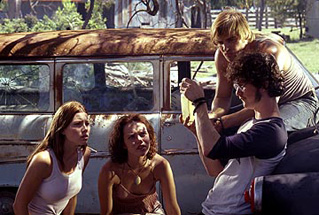Win/Lose
By Ryan O'Neill
August 26, 2009
The new Texas Chainsaw Massacre was the first and most successful film by Michael Bay's production company, Platinum Dunes. With a budget of only nine-and-a-half million dollars, the movie looks like it cost $50 million. Obviously, Bay brings the same type of quality control as a producer that he does as a director. First time director, Marcus Nispel, who gained notoriety in music videos much like Michael Bay, shows a very strong visual eye to begin his film career, using close-ups and a grimy setting to set a depressing mood before the killing even begins. Nispel then went on to direct the disastrous Pathfinder before being brought back into the Platinum Dunes family for Friday the 13th, which is not as good as Chainsaw but very similarly made.
Steve Jablonsky is Bay's go to man for film scores and he always delivers an incredible sound that adds to a movie's entertainment value. For Chainsaw, he composes an absolutely sickening score that makes the viewer want to go crawl into a corner somewhere and curl up into a ball. This is a very powerful, intense score, and I have to wonder how Jablonsky came up with such an evil sound.
Probably the most impressive aspect of Chainsaw Massacre is the fact that I found the entire film to be completely plausible. There is no lame humor to take the viewer out of the moment, no exaggerated deaths, or poor makeup and effects. Every single moment of this movie could take place to a group of individuals that just happened to be in the wrong place at the wrong time. The main male character, Eric Balfour, is the first to be murdered and that was a nice surprise that changes the usual routine of horror flicks. Balfour's death is a perfect example of the film's realism. He is creeping around a strange house and is distracted by the interior of a very dark and filthy room when Leatherface comes up from behind and hits him in the back of the head with a sledgehammer; one shot and goodnight. The character has no chance at all to defend himself, which is how it would be in real life, and I think that is one of the reasons why critics like Ebert were so traumatized by the film's brutality.
Two more standouts that are worth mentioning are Jessica Biel, who is more stunning here than any other film I've seen her in, and the narration of John Larroquette during the movie's prologue and epilogue, which combines with a stylish flash from an old fashioned camera and black and white cinematography.
If you include many of the DTV horrors that I have seen, I would estimate that I see at least 30 terrible horror movies to every one worth adding to my DVD collection. Released in 2003, Chainsaw was one of the first horror films to take itself completely seriously in a long time. Of course, many movies in the genre have now turned to gratuitous torture to try to promote being scary and that's a failure to discuss at another time. Chainsaw is actually far less gory then it seems. There is a small amount of blood in comparison to other restricted horror movies. It is the film's mood, relentless tone, and score that trick the viewer into thinking they have seen something far more sadistic that it really is. I highly recommend it to fans of the horror genre, and I can't stress enough that non fans need to stay far away. This movie will not put you in a good mood, and because of that it is quality filmmaking.
Continued:
1
2
3
|
|
|
|




